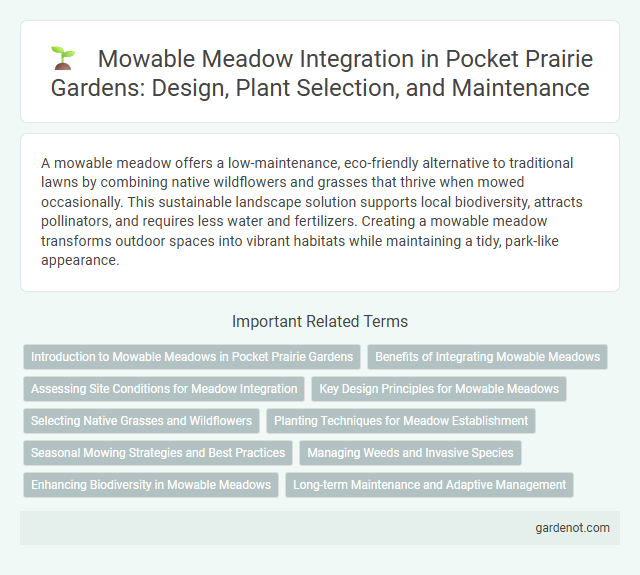A mowable meadow offers a low-maintenance, eco-friendly alternative to traditional lawns by combining native wildflowers and grasses that thrive when mowed occasionally. This sustainable landscape solution supports local biodiversity, attracts pollinators, and requires less water and fertilizers. Creating a mowable meadow transforms outdoor spaces into vibrant habitats while maintaining a tidy, park-like appearance.
Introduction to Mowable Meadows in Pocket Prairie Gardens
Mowable meadows in Pocket Prairie Gardens offer a low-maintenance, ecologically rich alternative to traditional lawns by combining native grasses and wildflowers that tolerate periodic mowing. These meadows support pollinators, improve soil health, and enhance biodiversity while maintaining a neat appearance suitable for residential and urban landscapes. Their design balance aesthetic appeal and environmental benefits, making them ideal for sustainable gardening practices.
Benefits of Integrating Mowable Meadows
Integrating mowable meadows within pocket prairies enhances biodiversity by providing habitats for pollinators and native wildlife while requiring less water and fertilizer than traditional lawns. These meadows improve soil health through deep root systems that reduce erosion and increase carbon sequestration. Their low-maintenance nature also reduces mowing frequency, lowering carbon emissions and operational costs.
Assessing Site Conditions for Meadow Integration
Assessing site conditions for integrating a mowable meadow involves evaluating soil type, drainage, and sunlight exposure to ensure optimal plant growth and meadow sustainability. Identifying existing vegetation and potential invasive species helps tailor the plant selection to the site's ecological characteristics. Understanding local climate patterns and maintenance capabilities further guides the design for a low-maintenance, biodiverse mowable meadow landscape.
Key Design Principles for Mowable Meadows
Mowable meadows incorporate strategic plant selection, favoring native grasses and wildflowers that thrive with periodic cutting, promoting biodiversity and ecological resilience. Design principles emphasize creating diverse layers of vegetation, ensuring mature seed heads for wildlife habitat while maintaining accessible paths for mowing equipment. Proper site preparation, soil assessment, and adaptive mowing schedules optimize meadow health and aesthetic appeal throughout growth cycles.
Selecting Native Grasses and Wildflowers
Selecting native grasses and wildflowers for a mowable meadow supports biodiversity while ensuring low maintenance and adaptability to local conditions. Choose species such as little bluestem, switchgrass, and purple coneflower that thrive in your soil type and climate zone, providing habitat and food for pollinators and wildlife. Native plants also promote soil health, reduce erosion, and require less watering compared to non-native alternatives.
Planting Techniques for Meadow Establishment
Selecting native, drought-tolerant grasses and wildflowers tailored to local soil and climate conditions enhances the success of mowable meadow establishment. Incorporating seed drilling or shallow broadcasting methods ensures even seed distribution and optimal soil contact, promoting strong germination rates. Regularly timed mowing at key growth stages controls invasive species while encouraging dense, healthy meadow development.
Seasonal Mowing Strategies and Best Practices
Seasonal mowing strategies for a mowable meadow involve timing cuts to promote native plant growth and support pollinator habitats, typically mowing once or twice annually during late spring and late fall. Best practices include avoiding mowing during peak blooming periods to maximize wildflower seed production and cutting at a height of 4-6 inches to protect root systems and encourage vigorous regrowth. Implementing rotational mowing zones enhances biodiversity by providing continuous habitat and food sources throughout the growing season.
Managing Weeds and Invasive Species
Managing weeds and invasive species in a mowable pocket prairie involves regular monitoring and targeted mowing schedules to prevent aggressive plants from dominating native grasses and wildflowers. Selective mowing during late summer or early fall can help control invasive species while allowing desired plants to flower and set seed. Integrating spot treatments with herbicides or manual removal techniques further enhances the health and biodiversity of the pocket prairie ecosystem.
Enhancing Biodiversity in Mowable Meadows
Mowable meadows in pocket prairies significantly enhance biodiversity by supporting a wide variety of native plants, insects, and pollinators while requiring minimal maintenance. These meadows create essential habitats for species such as butterflies, bees, and ground-nesting birds, contributing to local ecosystem health. Incorporating diverse native grasses and wildflowers promotes resilience against pests and environmental stress, making mowable meadows a sustainable option for promoting urban and suburban ecological balance.
Long-term Maintenance and Adaptive Management
Mowable meadows in pocket prairie designs require long-term maintenance strategies that balance seasonal mowing schedules with adaptive management to sustain native plant diversity and habitat quality. Regular mowing in late fall or early spring helps control invasive species, promote seed dispersal, and maintain desirable plant structure without disrupting pollinator activity. Adaptive management practices include monitoring plant community responses, adjusting mowing frequency, and incorporating prescribed burns or selective thinning to enhance ecological resilience over time.
Mowable meadow Infographic

 gardenot.com
gardenot.com